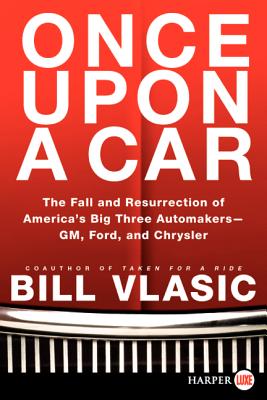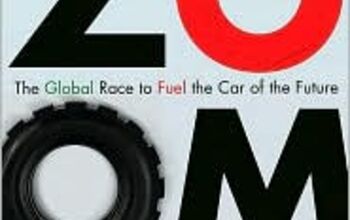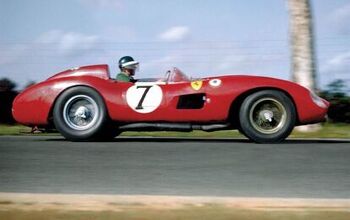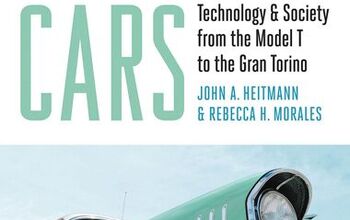Book Review: Once Upon A Car
“In the end, it was all about the car—designing, engineering, assembling, and selling a product that consumers wanted to own and drive.” So observes Bill Vlasic near the end of Once Upon a Car, his 379-page account of the recent “fall and resurrection” of the Detroit car manufacturers. Vlasic’s book is quite late to the party, following other journalistic accounts by Alex Taylor III and Paul Ingrassia and insider accounts by Steve Rattner and Bob Lutz. Can it possibly offer anything new? Is it worth reading? Yes, and yes. Yet Vlasic’s book also shares a fundamental weakness with the others, one all the more damning because of the above observation.
Taylor’s account is unique in that it explicitly includes the author’s personal experiences, personal relationships, and personal emotions. We learn what it was like to be a leading journalist covering the industry. Vlasic’s, like Ingrassia’s, does none of this. Instead, Vlasic artfully employs quotes gained through over 100 interviews (on top of those he conducted earlier as a reporter for the Detroit News, BusinessWeek, and the New York Times) to make readers feel like they’re the ones in the room, listening in. This is the book’s greatest strength. Despite not covering the decades before 2005, it’s 100 pages longer than Ingrassia, 140 pages longer than Taylor, yet reads more quickly and easily. Vlasic knows how to tell an engaging story.
But can an author completely divorce himself from his account? Vlasic avoids sharply criticizing any executives, and very often portrays them in a flattering light. The more positive portrayals also tend to be the most detailed, suggesting that Vlasic had the most access to their subjects. Of course, people expecting a positive portrayal are more likely to grant extended interviews, so this correlation is perhaps unavoidable. Ford executives Bill Ford, Alan Mulally, Mark Fields, and Jim Farley are especially well-covered. Rick Wagoner and Bob Lutz? They receive less attention than outsider-insiders Steve Girsky and Jerry York (the latter appears to have been an especially helpful informant). We hear that Chrysler’s cars required many improvements, but somehow the postively-portrayed Dieter Zetsche escapes any blame for this.
What Car Executives Really Care About
The UAW and its members are clearly focused on their paychecks. But not senior executives. Vlasic devotes many pages to Ford’s recruitment of Alan Mulally and Jim Farley. In both cases the pitch was highly emotional, ultimately winning over the executives by appealing to their patriotic desire to save an American icon, the Ford Motor Company. Cerberus head Stephen Feinberg was similarly motivated in his purchase of Chrysler. As was Ed Whitacre when fervently recruited by auto industry task force head Steven Rattner to serve as chairman of GM’s board.
The exception: when Cerberus paid “top dollar” to poach Jim Press from Toyota to serve (with no apparent impact, as Nardelli had no use for him) as co-President of Chrysler. Later Press begged to keep his job, not because he cared about the company or because of what he could do for it, but in order to avoid personal bankruptcy. FIAT CEO Sergio Marchionne, who had taken control of Chrysler, fired him anyway. A good morality play: those with non-monetary motivations triumph while the servants of mammon are shown the door.
Once at Ford, Alan Mulally emotionally connected with people, remarking that “I have never seen the depth of feeling for a company as these people have for Ford.” In return, Ford lifers, notoriously hard on outsiders, warmed to him, confided in him, and worked hard for him. At a big dealer meeting, Mulally “made” a group of Ford executives say “We love you” to the audience. This convinced Farley to join Ford, which he saw as like Toyota but “with a visceral, emotional component.” Once there, Farley worked to meet with as many dealers as possible and to forge personal connections with them.
Was it really so simple? Mulally supposedly wasn’t in it for the money, but you’d never know this from the massive size of his paycheck. Apparently non-financial motivations and large financial rewards are far from incompatible.
What Car Executives Think of One Another
One of my largest problems with Bob Lutz’s Car Guys vs. Bean Counters is that he hardly touches on his personal relationships within GM, and how they helped or hindered him. Vlasic to the rescue. We learn (a little) about tensions between Lutz and Cowager, who together failed to effectively manage GM’s North American Operations, and then a (quiet?) conflict between Lutz and Wagoner. Lutz disagreed with Wagoner’s heavy reliance on rebates to move the metal, preferring to improve the cars and let the rest take care of itself. From Wagoner’s perspective, Lutz didn’t recognize GM’s unavoidable need for short-term solutions and couldn’t be trusted with responsibility for the bottom line. Lutz hated charts, plans, and meetings. Wagoner thrived on them. Forced to toe the line, Lutz sarcastically referred to Wagoner as “our commander in chief,” someone he obeyed only because of their relative positions in the almighty hierarchy. Over at Ford, executives like Thursfield and Leclair tussled with everyone until they were pushed out. At Chrysler, Press was marginalized by Nardelli then fired by Marchionne.
Trust and Chemistry
Vlasic repeatedly touches upon one topic close to my own heart, as it consumed a decade of my life: the importance of trust and chemistry within organizations. With it, executives get a lot done. Without it, they don’t. We hear a lot about how Bill Ford and Jim Farley bonded over a shared love for the Mustang, and a bit about how Bill Ford and Barrack Obama bonded over a shared interest in green technology. Who knew cliches could be so effective? Upon meeting Bill Ford, Alan Mulally concluded, “I knew I could work with this guy.” Over at Chrysler, upon hearing that Cerberus had hired an outsider to take his place as head of the company, Tom Lasorda stated: “If I like Nardelli, I’ll stay. If I don’t, I’ll walk.” They clicked immediately. In contrast, we hear next to nothing about any clicking inside GM.
Ultimately, everyone was clicking with everyone else at the top of Ford. How did this come about? We learn a little about the steps Mulally took to reduce the initially high level of distrust within Ford. He emotionally connected with many people while actively suppressing infighting and quietly encouraging those who couldn’t adapt to a less political environment to leave the organization. Unfortunately, as much as Vlasic seems to get you into the room he never gets you into a room where people are actually performing real work. We hear about Mulully’s meetings with his senior executive team, at first weekly, later daily, but almost nothing about what went on inside these meetings, just that they had an “electric atmosphere” (those emotions again). Mulally built on effective team. But how? York notes that Mulally “forced” Ford’s executives to act as a team, but how did he manage to do this? Usually teamwork cannot be forced, but must be cultivated with a healthy helping of finesse.
Meetings: Good or Bad?
At GM, Lutz hates meetings and processes. At Ford, Mulally loves meetings and processes, and uses them to save the company. Granted, the gentlemanly meetings at GM were dull, guarded, and overly scripted (thanks to rounds of “pre-meetings”) while those at Ford were open and electrified by a sense of urgency. So it would seem that meetings and processes aren’t the problem, only dull or ineffective ones.
A Fundamental Weakness
While it’s clearly important to create great cars, there’s virtually nothing in the book about what was done to create the new cars upon which the current, still tentative resurrection rests. We hear that the new Ford Focus is great—because Ford product development chief Derrick Kuzak says so—but the story of how this greatness was achieved remains untold. Kuzak receives far less attention than Mulally, Fields, and Farley.
Ditto the Volt, the subject of the quote with which I began this review. After reading all of the recent auto industry books, including Lutz’s own, I still have very little idea of what “Maximum Bob” actually did at GM to improve its products. What were any of these executives like to work for? Like Taylor, Ingrassia, and so on Vlasic interviewed few if any people below the senior executive level, and if he asked any underlings what these senior executives really did and what they were really like to work for he divulges very little of it.
We read about this or that executive’s enthusiasm for “the product.” Giving these executives the benefit of the doubt, and assuming that this stated enthusiasm was more than a mantra, it might be essential but it’s far from sufficient. There have been plenty of car enthusiasts involved in the creation of every failed automobile. What has varied is how well these enthusiasts have been able to get done what they felt should have been done. One enabler that is implied within the book: senior executives who support these enthusiasts and prioritize their goals over others within the organization. But this is just scratching the surface.
The Unexpected Exception
We do hear how some specific product improvements came to be, but it’s an exception that very much proves the rule. Chrysler redesigned or heavily revised the interiors of nearly every one of its products for the 2011 model year—an impressive feat. FIAT will get credit for many of these. But Vlasic recounts how Bob Nardelli, CEO of the company under Cerberus, went through the cars and personally ordered 200 changes. The oddity: Nardelli was an outsider with no experience within the industry. He’s far from a car guy. He was the guy at the very top. Yet he’s the one who made these changes happen. One way to get them done, to be sure, but far from the way it should be done—where were the designers?—and a sign that the organization and process were badly broken. (We also hear a bit about Bob Lutz conducting similar reviews at GM, but entirely without specifics.)
Conclusion
Vlasic’s book is enjoyable to read, as he captures the personalities and the drama that transpired among them. We do often seem to be in the room. But look beyond what is in the book to ponder what isn’t, and you’ll realize that Vlasic rarely puts the reader in the right room. He repeatedly emphasizes that “it’s all about the car,” but as with many of the executives portrayed this is just lip service. If Vlasic walked the talk, we’d be reading about what was done to make better cars, and how well these attempts played out. Instead we read far more about executive suite politics, the recruitment of this or that star player, attempted end runs by outside investors, labor negotiations, and, of course, the government bailout. The book mirrors executives’ failure to focus on the cars even as it criticizes them for this failure. Despite all of the books about the auto industry’s recent brush with bankruptcy, the stories that really matter remain untold.
Michael Karesh lives in West Bloomfield, Michigan, with his wife and three children. In 2003 he received a Ph.D. from the University of Chicago. While in Chicago he worked at the National Opinion Research Center, a leader in the field of survey research. For his doctoral thesis, he spent a year-and-a-half inside an automaker studying how and how well it understood consumers when developing new products. While pursuing the degree he taught consumer behavior and product development at Oakland University. Since 1999, he has contributed auto reviews to Epinions, where he is currently one of two people in charge of the autos section. Since earning the degree he has continued to care for his children (school, gymnastics, tae-kwan-do...) and write reviews for Epinions and, more recently, The Truth About Cars while developing TrueDelta, a vehicle reliability and price comparison site.
More by Michael Karesh
Latest Car Reviews
Read moreLatest Product Reviews
Read moreRecent Comments
- Slavuta I drove it but previous style. Its big, with numb steering feel, and transmission that takes away from whatever the engine has.
- Wjtinfwb Rivaled only by the Prowler and Thunderbird as retro vehicles that missed the mark... by a mile.
- Wjtinfwb Tennessee is a Right to Work state. The UAW will have a bit less leverage there than in Michigan, which repealed R t W a couple years ago. And how much leverage will the UAW really have in Chattanooga. That plant builds ID. 4 and Atlas, neither of which are setting the world afire, sales wise. I'd have thought VW would have learned the UAW plays by different rules than the placid German unions from the Westmoreland PA debacle. But history has shown VW to be exceptionally slow learners. Watching with interest.
- Ravenuer Haven't seen one of these in years! Forgot they existed.
- Pig_Iron I one of those weirdos who liked these.


































Comments
Join the conversation
The story I want to hear is how the engineers and designers managed to create the products upon which the domestic auto industry is basing its renaissance while the industry was cutting to the bone and going through bankruptcies. Any all-new 2012 model car was already being worked on before the bankruptcies of GM and Chrysler. As a complete outsider, it looks to me like Alan Mullaly was successful at changing Ford's corporate culture. Ford always had a reputation as a very political place where people guarded their power and their personal fiefdoms. I think that because of GM's structure Lutz could never effect the same kind of changes at GM. Chrysler, an effective organization in the '90s, got looted by Daimler and was a shell of its former self by the time Cerberus got there to pick the bones. Marchionne gets credit for the refreshed Chrysler lineup but the work was done by a skeleton crew in Auburn Hills.
I keep reading how GM will not make it?????????????? They have solved their production cost issues, launched several new and popular car and SUV lines, including their first US built "world class" compact. They have been profitable for several quarters, lead total sales, and aren't totally dependent on trucks anymore. Seems they are doing something right.